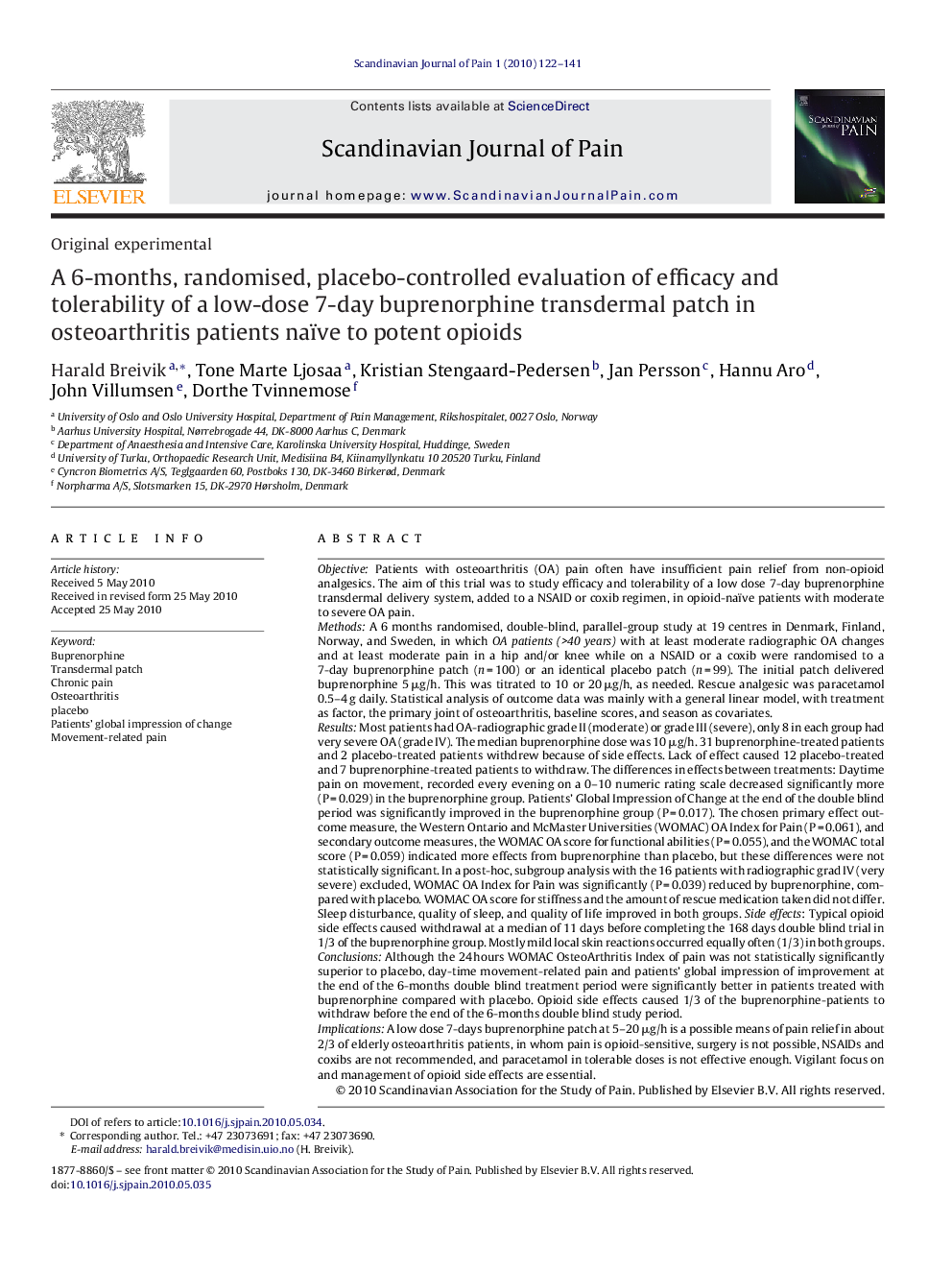| کد مقاله | کد نشریه | سال انتشار | مقاله انگلیسی | نسخه تمام متن |
|---|---|---|---|---|
| 2770970 | 1567832 | 2010 | 20 صفحه PDF | دانلود رایگان |

ObjectivePatients with osteoarthritis (OA) pain often have insufficient pain relief from non-opioid analgesics. The aim of this trial was to study efficacy and tolerability of a low dose 7-day buprenorphine transdermal delivery system, added to a NSAID or coxib regimen, in opioid-naïve patients with moderate to severe OA pain.MethodsA 6 months randomised, double-blind, parallel-group study at 19 centres in Denmark, Finland, Norway, and Sweden, in which OA patients (>40 years) with at least moderate radiographic OA changes and at least moderate pain in a hip and/or knee while on a NSAID or a coxib were randomised to a 7-day buprenorphine patch (n = 100) or an identical placebo patch (n = 99). The initial patch delivered buprenorphine 5 μg/h. This was titrated to 10 or 20 μg/h, as needed. Rescue analgesic was paracetamol 0.5–4 g daily. Statistical analysis of outcome data was mainly with a general linear model, with treatment as factor, the primary joint of osteoarthritis, baseline scores, and season as covariates.ResultsMost patients had OA-radiographic grade II (moderate) or grade III (severe), only 8 in each group had very severe OA (grade IV). The median buprenorphine dose was 10 μg/h. 31 buprenorphine-treated patients and 2 placebo-treated patients withdrew because of side effects. Lack of effect caused 12 placebo-treated and 7 buprenorphine-treated patients to withdraw. The differences in effects between treatments: Daytime pain on movement, recorded every evening on a 0–10 numeric rating scale decreased significantly more (P = 0.029) in the buprenorphine group. Patients’ Global Impression of Change at the end of the double blind period was significantly improved in the buprenorphine group (P = 0.017). The chosen primary effect outcome measure, the Western Ontario and McMaster Universities (WOMAC) OA Index for Pain (P = 0.061), and secondary outcome measures, the WOMAC OA score for functional abilities (P = 0.055), and the WOMAC total score (P = 0.059) indicated more effects from buprenorphine than placebo, but these differences were not statistically significant. In a post-hoc, subgroup analysis with the 16 patients with radiographic grad IV (very severe) excluded, WOMAC OA Index for Pain was significantly (P = 0.039) reduced by buprenorphine, compared with placebo. WOMAC OA score for stiffness and the amount of rescue medication taken did not differ. Sleep disturbance, quality of sleep, and quality of life improved in both groups. Side effects: Typical opioid side effects caused withdrawal at a median of 11 days before completing the 168 days double blind trial in 1/3 of the buprenorphine group. Mostly mild local skin reactions occurred equally often (1/3) in both groups.ConclusionsAlthough the 24 hours WOMAC OsteoArthritis Index of pain was not statistically significantly superior to placebo, day-time movement-related pain and patients’ global impression of improvement at the end of the 6-months double blind treatment period were significantly better in patients treated with buprenorphine compared with placebo. Opioid side effects caused 1/3 of the buprenorphine-patients to withdraw before the end of the 6-months double blind study period.ImplicationsA low dose 7-days buprenorphine patch at 5–20 μg/h is a possible means of pain relief in about 2/3 of elderly osteoarthritis patients, in whom pain is opioid-sensitive, surgery is not possible, NSAIDs and coxibs are not recommended, and paracetamol in tolerable doses is not effective enough. Vigilant focus on and management of opioid side effects are essential.
Journal: Scandinavian Journal of Pain - Volume 1, Issue 3, July 2010, Pages 122–141